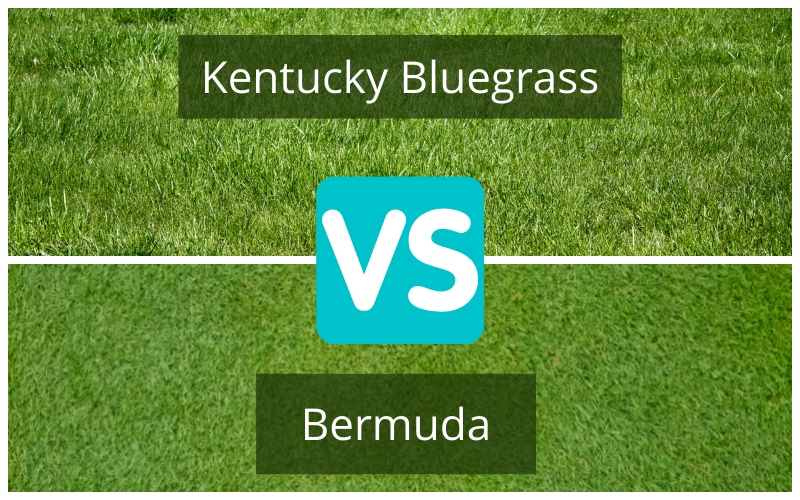Both Kentucky Bluegrass and Bermudagrass have a similar, attractive dark green color. Beyond this, however, these two types of grass are very different. They prefer different soil types and climates, have different mowing needs, and even feel completely different to the touch. Below you can learn everything you need to know before choosing between these two grass types.

Comparing Kentucky Bluegrass vs. Bermuda
The main points to pay attention to when you’re comparing Bermuda vs Kentucky Bluegrass are texture, ideal soil type, and mowing needs. These three factors are the most different and can make the most difference if you decide to plant Bermudagrass or Kentucky Bluegrass. For example, while Kentucky Bluegrass is soft and smooth, Bermudagrass can feel a little prickly in the summer.
Appearance of Kentucky Bluegrass and Bermudagrass
Kentucky Bluegrass has dark green blades with a fine appearance and texture. These blades are also “plump” and may appear rounded on the edges and at the ends, even shortly after mowing. This gives the grass a soft, pleasant texture.
Bermudagrass is also dark green when healthy but has a coarse texture. The width of the blades is medium-fine. Each blade of grass will have small hairs on the leaf sheath and there may be stolons visible between the clumps of grass. Stolons are white or pale-green “above-ground roots” that link the different clumps of Bermudagrass together to form a lawn.
Best Uses for Kentucky Bluegrass vs Best Uses for Bermuda
This is the section for a quick answer to which grass type, Bermuda grass vs Kentucky Bluegrass, is going to be better for your situation. For example, the best use for Kentucky Bluegrass would be an athletic field or a home lawn where there’s a lot of traffic. The yard should have a neutral pH, be in a warm or transition zone, and have well-drained, loamy soil. Slopes and lawns where you might park a car occasionally will also do well with Kentucky Bluegrass.
Bermudagrass, on the other hand, is for a low-traffic area or an area where there is only flat, well-drained soil and there is unlikely to be any running on the grass. Ideally, this yard will be in an area that is very warm as Bermuda prefers USDA zones 7a+.
Soil Types and pH Needs of Kentucky Bluegrass vs. Needs of Bermudagrass
Both Bermudagrass and Kentucky Bluegrass do best with a neutral to slightly acidic soil, the pH range should be 6 to 7. Further, both Bermuda and Kentucky Bluegrass prefer well-drained, rich soil. Kentucky Bluegrass can handle slightly wetter soil than Bermuda, though Bermuda can handle sandy soil which is something Kentucky Bluegrass struggles with.
Water Needs for Kentucky Bluegrass Lawns vs. Water Needs for Bermuda Lawns
The difference between Bermuda grass and Kentucky Bluegrass, when it comes to water consumption, is negligible. Both Bermuda and Kentucky Bluegrass have an ideal water requirement of 1.5” a week. This is slightly above the average, though Kentucky Bluegrass can handle less per week at 1” minimum while Bermudagrass prefers slightly more at 1.25” minimum.
Sun, Shade, and Temperature Requirements for Kentucky Bluegrass vs Bermuda
Kentucky Bluegrass prefers hot weather and full sun. It can, however, handle dappled or temporary shade as long as it gets at least 4 full hours of sun every day. Kentucky Bluegrass in deep shape or when covered by shade for longer periods may thin and eventually die off. Kentucky Bluegrass will go dormant and stop growing when temperatures reach and rise above 80F or reach and fall below 50F. A hard freeze or any temperature below 32F for weeks on end can cause damage or death to Kentucky Bluegrass lawns.
Bermudagrass is very similar in that it requires hot temperatures and full sun to both survive and thrive. However, Bermuda does not like any type of shade and may begin to thin in even dappled shade. If you have shady areas on your lawn, you may want to mix another more shade-tolerant grass variety into these patches of lawn. Bermudagrass will go dormant at and below 32F or at and above 85F. A hard freeze for an extended time is likely to cause damage to your Bermuda grass and may result in some of it dying back.
Durability of Kentucky Bluegrass vs Bermudagrass Lawns
Kentucky Bluegrass is very durable. It is suitable for slopes of all kinds, even in damp conditions and part-clay soils as long as there is still good drainage and water does not tend to pool. Kentucky Bluegrass will heal quickly if it is cut or damaged and is smart about nutrient storage and management.
Bermuda grass is far less durable. It is not suitable for wet, sloped areas. It will grow back more slowly than Kentucky Bluegrass if cut or ripped up. However, all stolon-based grasses are less durable than other types. While the stolons can dig in and create a good-looking lawn that is lower maintenance than many other types, they don’t encourage deep root development and as such is easier to move out of place in wet conditions or with force.
Common Pests and Diseases for Kentucky Bluegrass or Bermudagrass
Kentucky Bluegrass attracts geese more than other grasses. It also has its fair share of trouble with ants, webworms, grubs, and thrips like any grass. To be specific, owners of a Kentucky Bluegrass lawn will need to keep an eye on spore-based diseases such as powdery mildew. With good airflow and drainage, this risk can be minimized.
While Bermudagrass has the same insect risk as Kentucky Bluegrass and most grasses, it also comes with a handful of specific warnings. Given its slow recovery rate, digging animals can be a major problem. Further, too much rain or humidity can cause moss and algae to show up. Root rot is also a possibility if a mold problem goes too far.
Mowing Needs of Kentucky Bluegrass vs. Mowing Needs of Bermuda
Here, too, Kentucky Bluegrass shows just how durable it is. Kentucky Bluegrass can be mown down to just 1” without damage or fear or scalping the lawn. On average, it should be kept at 2” to 3”. It grows best and fastest in cool weather so you will need to mow it the most in the spring and fall.
Bermuda is trickier with the sweet spot for mowing being 2”, give or take .5”. Bermudagrass grows best in hot weather so it will need to be mown the most in the summer, once a week on average.
Are There Better Strains of Kentucky Bluegrass or Bermuda?
Yes, both of these grass types have special strains that can help you create the perfect lawn. Kentucky Bluegrass, for example, offers over 200 strains, all specialized and patented. Some can stay green for longer without water, others green up faster in the spring, and more. Some strains even tackle two issues at once. This is a well-studied grass type. If you’re interested in planting Kentucky Bluegrass, it’s a good idea to talk to a local distributor to see what’s available in your area.
Bermudagrass has fewer strains on offer than Kentucky Bluegrass though there are several that offer advantages you shouldn’t pass up, such as resistance to root rot or reduced water consumption. Like Kentucky Bluegrass, the best way to find out what is available to you is to contact a local seed store or sod distributor.
Kentucky Bluegrass vs. Bermuda Grass Cost
Kentucky Bluegrass and Bermudagrass will cost about the same amount to get started. Both of these grass types are easy to start from seed and produce fast results. At the time of this writing, the more common strains of Kentucky Bluegrass and Bermudagrass were going for $8 to $10 a pound for an average-sized lawn.
Can You Mix Bermuda and Kentucky Bluegrass?
Yes, you can mix Kentucky Bluegrass and Bermudagrass. The combination is sometimes called “blumuda” and offers good results in transition zones or places where it just takes the Bermuda longer than it should to green up in the spring. This combination also works well in a shady yard with Bermuda being the primary grass type and Kentucky Bluegrass filling in around the shady spots.
The Best-Case Scenario for a Kentucky Bluegrass or Bermuda Lawn
Separately, Kentucky Bluegrass and Bermuda each have ideal scenarios. For Kentucky Bluegrass that means a neutral pH, moist, well-drained soil under a high traffic lawn in or just above the transition zones. For Bermuda, this means a low-traffic lawn on flat terrain with a neutral pH, good drainage, and full sun.
I’ve summarized the main points when comparing Kentucky Bluegrass vs Bermuda below for easy reference.
| Grass Type | Kentucky Bluegrass | Bermuda Grass |
|---|---|---|
| Appearance | Dark Green with Plump, Fine Blades | Dark Green with a Coarse Texture – Small Hairs on Leaf Sheath - Stolons |
| Popular Uses | Golf Courses and Athletic Fields, Roadsides | Residential Areas or Low-Traffic Sports, Warm to Hot Climate with Average Traffic |
| Ideal Soil Type and pH | Well-Drained to Moist – 6 to 7 Ideal pH | Well-Drained to Moist – 6 to 7 Ideal pH |
| Water Requirements | 1.25 to 1.5” of Water Per Week – Slightly Above Average Water Consumption | 1” to 1.5” of Water Per Week – Average Overall Water Consumption |
| Sun/Shade/Temperature Needs | Full Sun Preferred/Dormant Below 50F and Above 80F | Full Sun Required – True Dormancy at 32F – Stopped Growth Below 55F |
| Durability | High Durability, Fast Recovery | Average Durability and Recovery Rate |
| Pests and Diseases | Geese, Digging Animals – Ants/Webworms/Thrips/Grubs – Spore-Based Diseases | Mold, Mildew, Moss, and Algae if Too Moist – Webworms, Thrips, Grubs – Digging Animals |
| Mowing Needs | Can Be Mown to 1” or Less – 2 to 3” Height Average – Grows Best in Cool Weather | Should Be Mown to 1.5” to 2.5” On Average – Grows Best in Warm to Hot Weather |


Leave a Reply